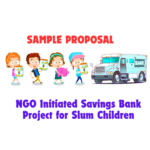Introduction: Sample Proposal on NGO Initiated Savings Bank Project for Slum Children, Slum-dwelling children face numerous challenges, including limited access to basic amenities and educational opportunities. Financial literacy and the ability to save are critical skills that can significantly impact their future prospects.
However, many of these children live in environments where formal banking systems are inaccessible or unaffordable. This gap presents a unique opportunity for NGOs to intervene and empower these children through innovative financial inclusion programs.
The objective of this proposal is to introduce an NGO-initiated saving bank project specifically designed for slum children. This project aims to instill the values of saving and financial responsibility at an early age, thereby laying a solid foundation for their future financial independence and self-reliance.
Inspired by the Saving Bank Project highlighted by ACEs, which emphasizes the importance of teaching children about saving and reusing materials creatively, this proposal seeks to adapt and scale this concept for slum children. The project will utilize simple, reusable containers as saving banks, encouraging children to save small amounts of money regularly. This approach not only promotes financial literacy but also aligns with environmental sustainability by reducing waste.
Conceptual Framework as to how the NGO initiated bank will work (Sample Proposal on NGO Initiated Savings Bank Project for Slum Children)
Building upon the concept of traditional saving banks, the proposed NGO-initiated interest-based saving bank project for slum children introduces a novel approach to financial education and savings. Unlike conventional saving banks, this project does not involve children physically collecting and storing money; instead, it focuses on the conceptual understanding of banking and the earning of interest on savings. This innovative model aims to familiarize children with the workings of a real bank, preparing them for adulthood by instilling financial literacy and the habit of saving.
At the heart of this project is the idea that NGOs will collect a fixed amount of money from children on a weekly basis. This collected sum will then be managed by the NGO, which will earn interest on it through various investment methods. A portion of this earned interest will be returned to the children, simulating the interest received from a bank account. This dual function—collecting savings and returning interest—aims to teach children about the basics of banking and the power of compound interest.
Implementation Details
To implement this project, NGOs will need to establish a structured system for collecting weekly contributions from children. This could involve setting up designated collection points in schools or community centers, where children can deposit their savings. The collected funds will then be pooled together and invested in safe, low-risk investments, such as government bonds or savings accounts with reputable banks. The interest earned from these investments will be calculated based on standard banking principles and a predetermined rate of return.
Children will receive a portion of this interest, demonstrating the concept of earning returns on their savings. This process will be accompanied by educational workshops and activities that explain the mechanics of banking, the importance of saving, and the benefits of compound interest. Through these interactions, children will gain a practical understanding of how banks operate and the value of saving for future goals.
Educational Component
In addition to the financial transactions, the project will incorporate educational components focused on financial literacy. Workshops will cover topics such as the difference between saving and spending, the concept of interest, and the importance of planning for the future. These sessions will be designed to be engaging and interactive, using games, stories, and real-life examples to illustrate financial concepts.
Long-Term Goals (Sample Proposal on NGO Initiated Savings Bank Project for Slum Children)
The ultimate goal of this project is to prepare slum children for adulthood by equipping them with the financial skills and knowledge necessary to navigate the world of banking and finance. By becoming familiar with the concept of earning interest on savings, children will be better prepared to open their own bank accounts, understand loan agreements, and make informed financial decisions. This project aims to break the cycle of poverty by fostering a culture of savings and financial responsibility among slum children.
Detailed Plan for Rolling Out the Savings Bank Project Across Targeted Slum Areas
The implementation strategy for the NGO-initiated interest-based savings bank project begins with a thorough assessment of the target slum areas to identify the most effective entry points and engagement mechanisms. The NGO outreach team will conduct preliminary surveys to gauge the level of interest in financial education and savings among children, parents, and community leaders. Based on these findings, the team will devise a phased rollout plan, starting with pilot projects in selected slums to test the feasibility and acceptance of the program.
Key elements of the roll out plan include:
- Weekly Collection Points: Establishing designated locations within schools or community centers where children can safely deposit their weekly savings. These points will be staffed by trained volunteers to ensure transparency and security.
- Educational Workshops: Organizing workshops for children, parents, and community members to introduce the concept of the savings bank project and its benefits. These workshops will cover the basics of banking, the importance of saving, and the concept of earning interest.
- Partnerships with Local Banks: Collaborating with local banks to provide financial education and potentially offer special savings accounts for children participating in the project. This partnership will also facilitate the transfer of collected funds to secure bank accounts, allowing the NGO to earn interest on behalf of the children.
Strategies for Engaging Children, Parents, and Community Members in the Project
Engagement strategies will be tailored to meet the unique needs and interests of the target population, ensuring that the project resonates with both children and their communities. Here are some strategies to consider:
- Regular Outreach Activities: The NGO outreach team will conduct weekly visits to the slum areas to collect savings, distribute educational materials, and provide updates on the project. These visits will also serve as an opportunity to address any concerns or issues raised by the community.
- Parental Involvement: Encouraging parental participation through home visits and workshops. Educating parents about the benefits of financial literacy and savings for their children, and providing tips on how to support their children’s participation in the project.
- Community Workshops: Hosting community-wide workshops to discuss the project’s goals and benefits, and to gather feedback from residents. These workshops will also serve as a platform for addressing common misconceptions about banking and savings.
- Rewards and Recognition: Introducing a rewards system for children who consistently save and demonstrate good financial habits. This could include certificates of achievement, small gifts, or recognition events within the community.
Linkage to Local Savings Banks
To further enhance the project’s impact, efforts will be made to link participating children with local savings banks. This linkage will not only expose children to the formal banking sector but also provide them with an opportunity to open their own savings accounts, further integrating them into the financial system. The NGO will work closely with local banks to ensure that the requirements for opening an account are accessible and suitable for children, addressing common barriers such as membership fees and minimum deposits.
The implementation strategy for the NGO-initiated interest-based savings bank project is designed to be flexible and responsive to the needs of the target communities. By involving children, parents, and community members in every stage of the project, the NGO aims to create a sustainable and impactful financial education initiative that prepares slum children for a financially literate future.
Benefits and Expected Outcomes (Sample Proposal on NGO Initiated Savings Bank Project for Slum Children)
The NGO-initiated interest-based savings bank project is poised to bring about significant positive changes in the lives of slum children, particularly in terms of financial literacy and savings habits. Here are some of the expected benefits:
- Improved Financial Literacy: Children will gain a deeper understanding of financial concepts such as saving, earning interest, and the importance of budgeting. This foundational knowledge is crucial for making informed financial decisions throughout their lives.
- Increased Savings: By receiving a small interest on their weekly contributions, children will develop a habit of saving. Over time, this accumulated savings can provide a safety net for unexpected expenses, educational costs, or even starting a small business.
- Enhanced Opportunities for Higher Education and Career Aspirations: With a better grasp of financial management, children may be more inclined to pursue higher education or vocational training, knowing that they have the financial means to support themselves during their studies. This can lead to improved job prospects and career advancement opportunities.
Expected Outcomes for the Community
The project is not just about benefiting individual children; it also aims to strengthen the broader community by fostering financial resilience and reducing dependence on external aid. Here are some of the expected outcomes:
- Reduced Reliance on External Aid: As children become more financially independent and capable of managing their finances, the overall reliance on external aid within the community may decrease. This shift towards self-sufficiency can lead to greater community stability and resilience.
- Increased Resilience against Financial Shocks: By teaching children about the importance of savings and the power of interest, the project helps build a culture of financial preparedness. This can make the community more resilient to financial shocks, such as job losses or sudden expenses, by having a pool of savings to draw upon.
- Community Engagement in Financial Education: The project’s success in improving financial literacy among children can inspire broader community engagement in financial education initiatives. Schools, colleges, and community centers might collaborate to integrate financial literacy into their curricula, creating a ripple effect that benefits future generations.
The NGO-initiated interest-based savings bank project stands to revolutionize the financial landscape for slum children, equipping them with the tools and knowledge to navigate the financial world confidently. By focusing on financial literacy, savings, and the earning of interest, this project not only empowers individual children but also strengthens the entire community, fostering a culture of financial resilience and independence.
The Monitoring and Evaluation (M&E) Plan (Sample Proposal on NGO Initiated Savings Bank Project for Slum Children)
The monitoring and evaluation (M&E) plan for the NGO-initiated interest-based savings bank project will employ a combination of quantitative and qualitative methods to track progress and assess the project’s effectiveness. Drawing inspiration from the World Bank’s approach to M&E, which emphasizes the use of key performance indicators (KPIs) and participatory evaluation methods, the project will adopt the following strategies:
| S No. | Key Performance Indicator | Definition | Measurement Method |
| 1 | Participation Rate | The percentage of children enrolled in the savings bank project relative to the total number of eligible children in the targeted slum areas.
|
Calculate the ratio of children actively participating in the project to the total number of children in the targeted area. |
| 2 | Average Weekly Savings | The average amount of money saved by children per week. | Sum the weekly savings of all participating children and divide by the number of children |
| 3 | Interest Earned
|
The total amount of interest earned by the children through the project. | Calculate the sum of interest paid to all participating children over a specified period. |
| 4 | Financial Literacy Score | A composite score reflecting children’s understanding of financial concepts, such as saving, interest, and budgeting.
|
Administer pre- and post-project assessments to measure changes in financial literacy. Scores can be derived from quizzes or tests covering relevant financial concepts. |
| 5 | Savings Habit Formation | The percentage of children who have formed a consistent savings habit as a result of the project.
|
Conduct surveys or interviews to determine the frequency of savings among children and calculate the percentage who report saving regularly. |
| 6 | Savings Habit Formation | The percentage of children who have formed a consistent savings habit as a result of the project.
|
Conduct surveys or interviews to determine the frequency of savings among children and calculate the percentage who report saving regularly. |
| 7 | Community Engagement | The level of involvement and support from parents, teachers, and community leaders in the project.
|
Use surveys or observation to assess the frequency of community meetings, attendance at workshops, and the number of community members involved in project activities. |
| 8 | Reduction in External Aid Dependency
|
The decrease in reliance on external aid for basic necessities or emergencies among participating children’s households.
|
Compare the frequency of external aid requests before and after the project’s implementation.
|
| 9 | Transition to Formal Banking Services | The percentage of children transitioning to formal banking services, such as opening a savings account, after participating in the project. | Track the number of children who open bank accounts or use formal banking services after completing the project. |
These KPIs collectively provide a comprehensive view of the project’s impact on children’s financial behaviors, their understanding of banking and savings, and the broader effects on the community. Regular monitoring and adjustment of these KPIs will ensure the project stays aligned with its objectives and achieves its intended outcomes.
- Participatory Evaluation: Involve children, parents, and community members in the evaluation process. This can be achieved through periodic surveys, focus group discussions, and feedback sessions. Participatory evaluation ensures that the project remains aligned with the needs and expectations of the beneficiaries, fostering a sense of ownership and engagement.
- Data Collection and Analysis: Utilize digital platforms for recording and analyzing data related to savings, interest earned, and financial literacy scores. Regular analysis of this data will provide insights into the project’s effectiveness and areas for improvement.
Criteria for Success and Indicators (Sample Proposal on NGO Initiated Savings Bank Project for Slum Children)
The success of the project will be measured against several criteria, each supported by specific indicators:
- Financial Literacy Improvement: Measure the increase in financial literacy among children through pre- and post-project assessments. Indicators could include the number of children able to correctly define key financial terms, the percentage of children demonstrating an understanding of the concept of interest, and the frequency of children seeking advice on financial matters.
- Savings Rate Increase: Track the average weekly savings per child and compare it over time to determine if the project has led to an increase in savings habits. This indicator will help assess whether the project is achieving its goal of motivating children to save.
- Interest Earning: Monitor the total interest earned by the children and the proportion of this interest that is reinvested or saved. This will indicate the project’s success in teaching children about the benefits of earning and reinvesting interest.
- Community Engagement: Evaluate the level of community engagement in the project through indicators such as the number of community members attending workshops, the frequency of community meetings discussing the project, and the presence of community-led savings schemes modeled after the project.
- Long-Term Financial Behavior: Assess the long-term impact of the project on children’s financial behavior by tracking their savings patterns, credit histories, and financial decision-making abilities as they transition into adulthood.
The monitoring and evaluation plan for the NGO-initiated interest-based savings bank project is designed to provide a comprehensive overview of the project’s progress and impact. By employing a mix of KPIs, participatory evaluation methods, and rigorous data analysis, the project will be able to accurately assess its effectiveness and make necessary adjustments to ensure it meets its objectives of improving financial literacy and promoting savings among slum children.
Resource Requirements (Sample Proposal on NGO Initiated Savings Bank Project for Slum Children)
Creating a budget for the NGO Initiated Interest-Based Savings Bank Project involves estimating the cost of various resources and personnel required to implement and sustain the project effectively. Below is a simplified table outlining the resource requirements and potential funding sources, along with estimated costs. Please note, these figures are illustrative and should be adjusted based on actual costs and availability of resources in the target areas.
Budget Allocation
| Resource Category | Estimated Cost |
| Stationery | $500 |
| Educational Materials | $1000 |
| Initial Seed Money | $2000 |
| Ongoing Support Fund | $3000 |
| Salary for Outreach Staff | $12000 |
| Trainers’ Salary | $8000 |
| Transportation | $1500 |
| Miscellaneous Expenses | $500 |
This is dummy budget; once you finalise your project you can tweak it as per your context or requirements.
Potential Partnerships and Funding Sources:
- Local Businesses and Corporations: Sponsorship for stationery, educational materials, and transportation.
- Government Grants: Applications for grants aimed at social development and financial literacy programs.
- International Donor Organizations: Collaboration with international NGOs and donor agencies interested in financial inclusion projects.
- Crowdfunding Platforms: Raising funds through online campaigns targeting supporters of financial education and empowerment.
- Community Fundraisers: Organizing local events, sales, or auctions to generate funds for the project.
This budget and partnership strategy aim to ensure the project’s sustainability and scalability, leveraging a mix of direct funding, in-kind donations, and strategic partnerships to maximize the project’s impact.
In a nutshell, the NGO Initiated Interest-Based Savings Bank Project aims to empower slum children by fostering financial literacy and the habit of saving, ultimately preparing them for a financially stable future. This initiative goes beyond traditional saving banks by simulating the workings of a real bank, collecting a fixed amount from children weekly and returning a small interest, akin to how banks operate. The project’s implementation strategy includes detailed plans for rollout across targeted slum areas, engaging children, parents, and community members, and establishing partnerships with local banks for financial education and potential savings accounts. The benefits and expected outcomes range from improved financial literacy and increased savings among children to reduced reliance on external aid and increased community resilience. The monitoring and evaluation plan utilizes Key Performance Indicators (KPIs) to track progress and assess effectiveness, ensuring the project meets its objectives and achieves its intended impact.
Related Good Reads, Link
Hey, STEAL our Best Premium Content For Absolutely Free, Check Out the Links below
HOPE these will add value to your existing skills and knowledge
Our information bears no cost (it’s absolutely FREE), don’t let valuable information slip away.
Join our community of avid readers who are always in the know. Subscribe to our website; stay connected and engaged with the latest news, trends, and developments by subscribing today.
(PUSH the bell ICON)
Leverage the power of knowledge to propel your organization to new heights. Don’t miss out to explore our content
- Latest Funds for NGOs,
- NGO Jobs
- Resources (Helpful Guides and Courses)
- Premium Resources
- NGO related articles
Empowering Humanity through Funds, Resources and Collective Action
Sharing is Appreciated









